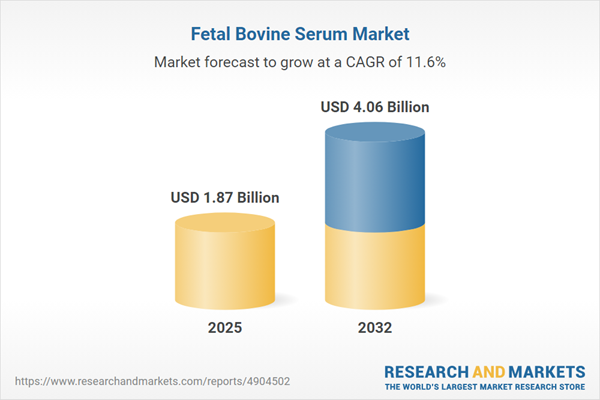Speak directly to the analyst to clarify any post sales queries you may have.
Senior leaders in the fetal bovine serum market face an evolving landscape marked by dynamic research needs, changing regulatory frameworks, and increasing emphasis on organizational flexibility. Steering through these shifts requires strategies focused on innovation, resilient supply chains, and operational adaptability.
Market Snapshot: Fetal Bovine Serum Market Trends and Dynamics
The fetal bovine serum market is experiencing robust expansion, driven by heightened demand across research and biomanufacturing sectors. As research applications and bioprocessing requirements diversify, organizations are enhancing product portfolios to support significant advancements in cell biology, oncology, regenerative medicine, and vaccine research. With research environments becoming increasingly sophisticated, industry participants are investing in advanced digital supply chain monitoring and compliance solutions to address complex regulatory and quality demands. These technology-driven changes are encouraging a shift toward more responsive and agile business models and highlight the importance of integrating innovation with scalable, reliable operations throughout the supply chain.
Scope & Segmentation for Strategic Decision-Makers
- Form: Liquid and lyophilized serum formats—used in rapid assays and long-term studies—deliver flexible solutions and ensure reliable batch consistency across a spectrum of research environments.
- Product Type: Charcoal stripped, dialyzed, gamma irradiated, high dose, low dose, and sterile filtered fetal bovine serum variants respond to advanced laboratory standards requiring accuracy and reproducibility.
- Packaging: Standardized vial sizes such as 10 ml, 50 ml, and 100 ml are engineered for streamlined procurement, inventory management, and logistics across distributed operations.
- Application: Utilization extends to animal cell culture, tissue engineering, toxicology testing, vaccine development, and early-stage drug discovery, establishing serum as foundational for both experimental and validated research protocols.
- End User: Key stakeholders include academic research centers, pharmaceutical and biotherapeutic companies, contract research and clinical laboratories, and agricultural biotechnology firms—all emphasizing the importance of innovation, efficiency, and scalable research support.
- Regional Coverage: Market deployment reflects regional diversity in regulations and infrastructure, revealing distinct market trends and procurement models in North America, Latin America, Europe, Asia-Pacific, and the Middle East & Africa.
- Companies Profiled: Leading producers such as Atlas Biologicals, Thermo Fisher, Merck KGaA, Danaher, and Biowest SAS prioritize transparent sourcing and global quality alignment—key for regulatory compliance and supply chain confidence.
Key Takeaways for Strategic Leaders
- Enhancing supply chain transparency using digital monitoring enables organizations to proactively manage compliance and reduce the risk of operational disruptions.
- Ongoing progress in serum filtration and irradiation technology helps laboratories maintain high standards for reproducibility and adaptable research outcomes across varied protocols.
- Sustainability efforts are increasingly central, aiming to decrease waste, streamline procurement, and harmonize operations with environmental and evolving regulatory expectations.
- The adoption of uniform packaging supports efficient inventory management for organizations active in both regional and global markets, facilitating scale and responsiveness.
- Partnerships with research institutions foster the evolution of serum solutions, enhance reliability of sourcing, and drive improvements in essential laboratory materials.
- Continuous monitoring of regulatory shifts allows organizations to remain agile and ensure ongoing access to critical markets while upholding compliance.
Tariff Impact: Responding to U.S. Trade Policy Shifts
Recent changes in U.S. trade policy are prompting supply chain strategists to diversify sourcing methods and expand supplier networks within the fetal bovine serum market. By emphasizing proactive inventory controls and comprehensive risk assessments, organizations can effectively manage uncertainties from trade dynamics and safeguard supply continuity.
Methodology & Data Sources
This market overview draws on direct feedback from laboratory technologists, procurement leaders, and supply chain professionals. Data are validated through regulatory documentation, peer-reviewed academic research, and independent third-party market analyses to ensure credible, actionable insights.
Why This Report Matters
- Provides procurement guidance that minimizes market vulnerabilities and supports proactive risk management for the fetal bovine serum industry.
- Enables consistent regulatory and quality compliance, ensuring reliability from source through to the end-use application.
- Equips senior executives to anticipate industry shifts, sharpen investment focus, and drive targeted innovation across the research continuum.
Conclusion
By gaining a strategic perspective of the fetal bovine serum market, leaders strengthen supplier partnerships and drive scientific progress. Organizational agility and responsiveness are essential for maintaining excellence and supporting sustained advancement.
Additional Product Information:
- Purchase of this report includes 1 year online access with quarterly updates.
- This report can be updated on request. Please contact our Customer Experience team using the Ask a Question widget on our website.
Table of Contents
3. Executive Summary
4. Market Overview
7. Cumulative Impact of Artificial Intelligence 2025
List of Figures
Companies Mentioned
The companies profiled in this Fetal Bovine Serum market report include:- Atlas Biologicals, Inc.
- Bio-Techne Corporation
- Biofargo
- Biosera
- Biowest SAS
- Capricorn Scientific
- Corning Incorporated
- Danaher Corporation
- GeneTex, Inc.
- HiMedia Laboratories Private Limited
- Innovative Bioscience
- Innovative Research
- MedSupply Partners
- Merck KGaA
- Neuromics
- Pan-Biotech GmbH
- Rocky Mountain Biologicals
- Serana Europe GmbH
- SeraPrime, LLC
- Thermo Fisher Scientific Inc.
- VWR International, LLC
- Zen-Bio, Inc.
- Seraglob by Bioswisstec Ltd
- Bio Basic Inc.
- Takara Bio Inc.
Table Information
| Report Attribute | Details |
|---|---|
| No. of Pages | 192 |
| Published | November 2025 |
| Forecast Period | 2025 - 2032 |
| Estimated Market Value ( USD | $ 1.87 Billion |
| Forecasted Market Value ( USD | $ 4.06 Billion |
| Compound Annual Growth Rate | 11.6% |
| Regions Covered | Global |
| No. of Companies Mentioned | 26 |









